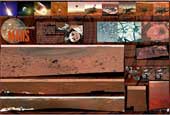
 |
|
|
Cosmic Biology is an astrobiology book intended for a popular market, a work based on science but in which speculation has been allowed to romp wildly. Mostly confined to examining the prospects for life in the Solar System, there is almost nothing about exoplanets and how we detect them. Hence, this is astrobiology with very little ‘astro’ and a lot of biology, laced with planetary science and some fairly painless chemistry, administered on a ‘need to know’ basis. Urwin and Shulze–Makuch start by attempting to define life, explaining the special place of carbon (and why silicon-based life is unlikely) and water. They unfold their story with sketchy accounts of how DNA and RNA encode genetic information, possible scenarios for how life on Earth originated, evolution, ecology, and how life developed on Earth. Then follows an exploration of ideas about life on the usual suspects – Mars, Venus and Europa – but also on the gas giants and their moons, Io, Titan and even Triton. At times a more didactic approach would have been useful. A systematic review of how organisms make a living would have helped readers get to grips with the variety of metabolic lifestyles that are referred to (the brief definitions in the text and glossary doesn’t provide the necessary overview). Key issues are missing: for example, the importance of plate tectonics for making Earth habitable is not discussed, despite a cryptic reference to the critical carbonate-silicate cycle in a figure, which is not explained. Occasionally the authors are not up-to-date: a plate tectonic origin for the northern lowlands of Mars no longer has the caché it had in 1994. But the most striking aspect of Cosmic Biology is the ‘reasonable speculation’ that has the authors draw up entire ecosystems for life on individual worlds. I suppose it depends on what you mean by reasonable, but since there is as yet no credible evidence for life anywhere than on Earth, I was left wondering what the point was. To be fair, the authors qualify their claims. So, at the end of the chapter on Europa we learn that its interior may not be hot enough for there to be the hydrothermal vents needed for life – well, exactly! Cosmic Biology is an easy read. You can treat it as a bit of fun and there are references at the end of each chapter if you want to be more critical. Or you might think that astrobiology is already plagued by too much rampant speculation. Alan Longstaff
|
|
|
|
2009 Yearbook This 132-page special edition features the ultimate observing guide for 2009, a review of all the biggest news stories of 2008, in depth articles covering all aspects of astronomy and space missions for 2009, previews of International Year of Astronomy events and much, much more. This 132-page special edition features the ultimate observing guide for 2009, a review of all the biggest news stories of 2008, in depth articles covering all aspects of astronomy and space missions for 2009, previews of International Year of Astronomy events and much, much more.Infinity Rising  This special publication features the photography of British astro-imager Nik Szymanek and covers a range of photographic methods from basic to advanced. Beautiful pictures of the night sky can be obtained with a simple camera and tripod before tackling more difficult projects, such as guided astrophotography through the telescope and CCD imaging. This special publication features the photography of British astro-imager Nik Szymanek and covers a range of photographic methods from basic to advanced. Beautiful pictures of the night sky can be obtained with a simple camera and tripod before tackling more difficult projects, such as guided astrophotography through the telescope and CCD imaging.Exploring Mars  Astronomy Now is pleased to announce the publication of Exploring Mars. The very best images of Mars taken by orbiting spacecraft and NASA's Spirit and Opportunity rovers fill up the 98 glossy pages of this special edition! Astronomy Now is pleased to announce the publication of Exploring Mars. The very best images of Mars taken by orbiting spacecraft and NASA's Spirit and Opportunity rovers fill up the 98 glossy pages of this special edition!Mars rover poster  This new poster features some of the best pictures from NASA's amazing Mars Exploration Rovers Spirit and Opportunity. This new poster features some of the best pictures from NASA's amazing Mars Exploration Rovers Spirit and Opportunity. |
||||||||||||||||||||||||